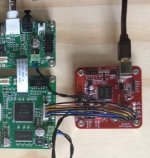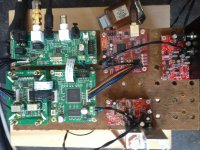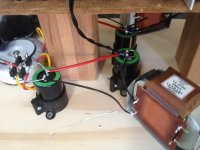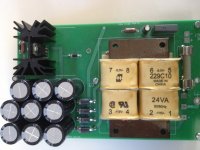Well through the spdif ground then?
I was asking if this PS shared a common ground with your analogue stages and the rest of your system, or whether there was galvanic isolation in between.
I was asking if this PS shared a common ground with your analogue stages and the rest of your system, or whether there was galvanic isolation in between.
Everything has its own dedicated powersupply, not even connected through safety ground. There's a pulse transformer on the spdif link. So I guess yes
Dunno what yes means, but you appear to be a master of ambiguity
The dedicated supplies or the lack of common safety ground are irrelevant. So, the choke PS for the clocks shares the same ground as the analogue part, amps and speakers, right?
fs
An attempt to loose all perceived ambiguity
- waveio has its own secondary winding, own rectifier, CLC, superreg
- FIFO + clocks have their own secondary winding, own rectifier, CLC, superreg
BUT waveio and FIFO share the same toroid primary, their secondaries are seperated
-D/A is a hypex dlcp with its own dedicated hypex SMPS powersupply
-A are hypex ncores with their own hypex SMPS powersupplies
But I have just a single phase entering my home driving it all.. What's totally galvanically isolated to you? A totally seperated phase for D and A or seperately battery powered or do I qualify
Last edited:
methinks you have forgotten about parasitics
if it's not too much effort please enlighten me, as I'm just starting on all this
fs
An attempt to loose all perceived ambiguity:
Thanks for the detailed description of your system. It is quite rare for a system to be without a common ground, but yours apparently qualifies. Not counting, of course, the parasitics as qusp appropriately noticed.
Which makes your conclusions even more remarkable.
Audio Component Grounding and Interconnection - see 4.2Thanks for the detailed description of your system. It is quite rare for a system to be without a common ground, but yours apparently qualifies. Not counting, of course, the parasitics as qusp appropriately noticed.
Which makes your conclusions even more remarkable.
edbk's system seems to have a common ground buss with "buss is formed from ordinary printed circuit traces and regular hookup wire between PC boards".
If he uses WaveIO's isolated I2S then his system might resemble what is in figure 4.2-1 otherwise 4.2-2.
Would be useful to see a drawing with all the modules and their interconnections.
edbk's system seems to have a common ground buss with "buss is formed from ordinary printed circuit traces and regular hookup wire between PC boards".
If he uses WaveIO's isolated I2S then his system might resemble what is in figure 4.2-1 otherwise 4.2-2.
Of course. I must have had too much sun today.
In that case, there is nothing unusual with his findings. Probably not straightforward to explain, but certainly not unusual.
I think it is a common enough observation that when one makes changes to a local PS sharing a common ground connection, audible effects may be experienced throughout the system. Whether this is by virtue of circulation ground currents, common mode ground noise or something entirely different is another matter.
So, the fact that a PS for a clock circuit has been enhanced with chokes does not in any way indicate it is the clock circuit that's contributing to the change in sound. It may, but not necessarily.
An alternative explanation can be found in this very interesting, if a bit too avant-garde thread:
Groundside Electrons - diyAudio
Of course. I must have had too much sun today.
In that case, there is nothing unusual with his findings. Probably not straightforward to explain, but certainly not unusual.
I think it is a common enough observation that when one makes changes to a local PS sharing a common ground connection, audible effects may be experienced throughout the system. Whether this is by virtue of circulation ground currents, common mode ground noise or something entirely different is another matter.
So, the fact that a PS for a clock circuit has been enhanced with chokes does not in any way indicate it is the clock circuit that's contributing to the change in sound. It may, but not necessarily.
An alternative explanation can be found in this very interesting, if a bit too avant-garde thread:
Groundside Electrons - diyAudio
Could you please explain my common ground?
A continuity tester between your clock PS ground and your DAC ground? Is it not common?
Not sure whether you drive the NCOREs balanced...
Well I'm enclined to think it's not common.
-The fifo has its own transformer-bridge-CLC powersupply.
-The dac has its own SMPS powersupply
-The connection between fifo and dac is spdif, there's a pulse transformer in between (actually I think there are 2, sending and receiving side).
The dac is a hypex dlcp, poweramps are hypex ncore's. The interconnects are differential. From the hypex datasheet:
The audio input is differential. This means that ground is not part of the audio signal.
The dac and poweramps all have their OWN dedicated hypex smps as powersupplies.
There are no safety ground connections anywhere.
edit: there's a connection between dac/poweramps for the balanced cable shield, that could be a ground connection in effect, although the hypex datasheet states its passive and not part of the signal. But I just dont know how it works
Last edited:
One picture is worth a thousand words...The connection between fifo and dac is spdif, there's a pulse transformer in between (actually I think there are 2, sending and receiving side).
You are correct, in your case there is no common ground between Fifo and DAC and everything seems to be wired correctly.
I have no idea how you experience those huge differences with minor changes to your PSU. What is this superreg you are using? For me the only logical explanation might be that your superreg is oscillating heavily.
One picture is worth a thousand words...
For me the only logical explanation might be that your superreg is oscillating heavily.
yep, that could easily be the case, there is a fair bit of capacitance on the boards and that could for sure be causing issues with the superreg, especially since the caps are low impedance types
yep, that could easily be the case, there is a fair bit of capacitance on the boards and that could for sure be causing issues with the superreg, especially since the caps are low impedance types
Wouldnt that have shown up in the linear audio vol.3 test of them?
Also why would the insertion of the L between CC remove the oscillation?
The pictures to maybe save a 1000 words
Hope this is not going to far OT..
Attachments
Well I'm enclined to think it's not common.
-The fifo has its own transformer-bridge-CLC powersupply.
-The dac has its own SMPS powersupply
-The connection between fifo and dac is spdif, there's a pulse transformer in between (actually I think there are 2, sending and receiving side).
The dac is a hypex dlcp, poweramps are hypex ncore's. The interconnects are differential. From the hypex datasheet:
You are correct, of course. I probably don't understand the spdif connection between fifo and dac...
Wouldnt that have shown up in the linear audio vol.3 test of them?
Also why would the insertion of the L between CC remove the oscillation?
The pictures to maybe save a 1000 words
Hope this is not going to far OT..
probably because they tested them while using them appropriately
it may not have removed the oscillation, just changed it, or perhaps the L damped the high frequency response somehow. i'm not guessing, pretty much all super regulators are not happy driving low impedance and somewhat highly capacitive loads and your pictures clearly show thats what you are doing. whether that definitely explains your results I dont know.
I really dont know, i'm just looking for reasons you arent hallucinating
probably because they tested them while using them appropriatelyfollowing the designer's recommendations. both Jack (the guy who set up the tests) and jan (the publisher of LA, who also used to sell the old colony official super regulators) are very familiar with Jung type regs. if you read the directions for these reg boards you will see he has specifically warned against using very low impedance caps on the output.
it may not have removed the oscillation, just changed it, or perhaps the L damped the high frequency response somehow. i'm not guessing, pretty much all super regulators are not happy driving low impedance and somewhat highly capacitive loads and your pictures clearly show thats what you are doing. whether that definitely explains your results I dont know.
I really dont know, i'm just looking for reasons you arent hallucinatingI dont really understand using fifo with spdif output with an asynchronous DAC/DSP in the first place if i'm honest.
Hehe
The reg has a single 50V/100uF cap on its output.
However it also has a 50V/100uF cap on its input. There I may have somewhat of an issue since its choke-47000uF-1 feet of awg20 twisted pair, then the reg's 100uF input capacitance. Maybe a little unwanted CLC action. Though still would not makes enough sense to me since the difference is very big.
I had the fifo long before the hypex dlcp, I though it had become obsolete because of the src but waveio isolated spdif -> dlcp is not even close to waveio -> fifo -> dlcp..
I am not imagining things, I've had others listen to the difference. And If I wanted to hear things why wouldnt the addition of the choke to the wavio PS improve my perception aswell? Since it doesnt seem better on that position, just oh so slightly different.
I was thinking about lower current draw from the power grid but if so then the effect would have had to be bigger on the wavio because it draws more then twice the current? Not the case so..
Now what if I reverse the question, why wouldnt a CLC supply provide a better/lower noise environment for the fifo/clock supply then C or CRC?
Some additions:
I've reread the Linear Audio (which actually was vol.4) article. They mention osccilation with the ad797 at 2.2MHz in jung/didden superregs, not there with the ad825. Mine have the AD825. Furthermore it seems like theyve been built with the sjostrom bom, I bought mine as completed modules. Used caps look like panasonic FR but not 100% sure there.
Also before I used simple LT1085 powersupplies for waveio/fifo as in attached photo, replacing those with C-sjostrom reg was a significant change for the better, for both waveio and fifo this time
I've reread the Linear Audio (which actually was vol.4) article. They mention osccilation with the ad797 at 2.2MHz in jung/didden superregs, not there with the ad825. Mine have the AD825. Furthermore it seems like theyve been built with the sjostrom bom, I bought mine as completed modules. Used caps look like panasonic FR but not 100% sure there.
Also before I used simple LT1085 powersupplies for waveio/fifo as in attached photo, replacing those with C-sjostrom reg was a significant change for the better, for both waveio and fifo this time
Attachments
- Home
- Source & Line
- Digital Line Level
- Asynchronous I2S FIFO project, an ultimate weapon to fight the jitter



